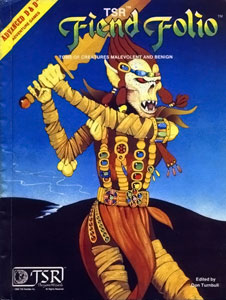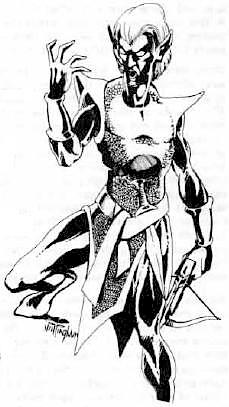
The drow or dark elves are a dark-skinned and white-haired subrace of elves connected to the subterranean Underdark in the Dungeons & Dragons fantasy roleplaying game. The drow have traditionally been portrayed as generally evil and connected to the evil spider goddess Lolth. However, later editions of Dungeons & Dragons have moved away from this portrayal and preassigned alignment. More recent publications have explored drow societies unconnected to Lolth.
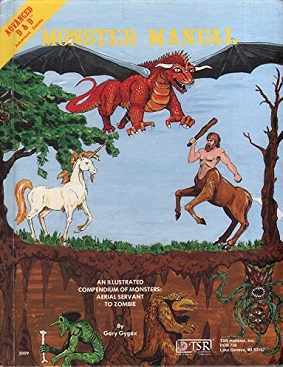
The Monster Manual is the primary bestiary sourcebook for monsters in the Dungeons & Dragons fantasy role-playing game, first published in 1977 by TSR. The Monster Manual was the first hardcover D&D book and includes monsters derived from mythology and folklore, as well as creatures created specifically for D&D. Creature descriptions include game-specific statistics, a brief description of its habits and habitats, and typically an image of the creature. Along with the Player's Handbook and Dungeon Master's Guide, the Monster Manual is one of the three "core rulebooks" in most editions of the D&D game. As such, new editions of the Monster Manual have been released for each edition of D&D. Due to the level of detail and illustration included in the 1977 release, the book was cited as a pivotal example of a new style of wargame books. Future editions would draw on various sources and act as a compendium of published monsters.

Monster Manual II is the title shared by two hardback rulebooks published for different versions of the Dungeons & Dragons (D&D) fantasy roleplaying game.
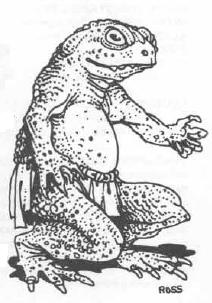
The slaad is a fictional monster in the Dungeons & Dragons fantasy role-playing game. They are extraplanar creatures (outsiders) that resemble giant humanoid toads of various colors, and other types, such as mud, and death slaadi.

Trolls are fictional monsters in the Dungeons & Dragons roleplaying game.
Several different editions of the Dungeons & Dragons (D&D) fantasy role-playing game have been produced since 1974. The current publisher of D&D, Wizards of the Coast, produces new materials only for the most current edition of the game. However, many D&D fans continue to play older versions of the game and some third-party companies continue to publish materials compatible with these older editions.

In the Dungeons & Dragons fantasy role-playing game, the mimic is a type of fictional monster. It is portrayed as being able to change its shape to disguise its body as an inanimate object, commonly a chest. The mimic uses a powerful adhesive that holds fast to creatures that touch it, allowing the mimic to beat its victims with its powerful pseudopods. The mimic was introduced in the first edition Advanced Dungeons & Dragons game's original Monster Manual. The mimic has appeared in subsequent editions. Several variants of the creature have been introduced, with a variety of abilities and sizes.

Descent Into the Depths of the Earth is an adventure module for the Dungeons & Dragons (D&D) fantasy roleplaying game coded D1–2. It was written by Gary Gygax, and combines two previously published modules from 1978, the original Descent into the Depths of the Earth and Shrine of the Kuo-Toa. A sequel to the first two modules, Vault of the Drow, was also published in 1978. All of these D-series modules were produced for use with the 1st edition Advanced Dungeons & Dragons (AD&D) rules.
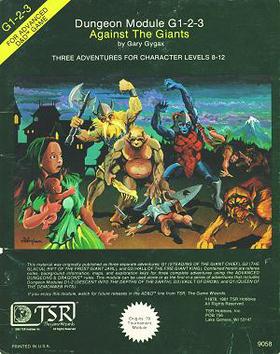
Against the Giants is an adventure module written by Gary Gygax and published by TSR in 1981 for the Dungeons & Dragons fantasy role-playing game. It combines the G series of modules previously published in 1978: Steading of the Hill Giant Chief, Glacial Rift of the Frost Giant Jarl, and Hall of the Fire Giant King. All three were produced for use with the 1st edition Advanced Dungeons & Dragons rules. In 1999, to recognize the 25th anniversary of TSR, the company released an updated version, Against the Giants: The Liberation of Geoff. Later in 1999, Wizards of the Coast published a novelization of Against the Giants by Ru Emerson.

Creature Catalogue is a supplement for Basic Dungeons & Dragons first released in 1986, and updated in 1993.

The Forgotten Temple of Tharizdun is an adventure module for the Dungeons & Dragons (D&D) role-playing game, for use in the World of Greyhawk campaign setting. The module was published by TSR, Inc. in 1982 for the first edition Advanced Dungeons & Dragons rules.

In the Dungeons & Dragons fantasy role-playing game, goblins are a common and fairly weak race of evil humanoid monsters. Goblins are non-human monsters that low-level player characters often face in combat.
In the Dungeons & Dragons fantasy role-playing game, the undead are a broad classification of monsters that can be encountered by player characters. Undead creatures are most often once-living creatures, which have been animated by spiritual or supernatural forces. They range from mindless remnants of corpses such as skeletons and zombies to highly intelligent creatures like vampires and liches, but in whatever form they take they are typically malevolent and threatening. Like most Dungeons & Dragons monsters, the various kinds of undead creatures are "drawn from classical, medieval, and fictional sources", and have in turn influenced the use of these kinds of monsters in other games.

In the Dungeons & Dragons fantasy role-playing game, giants are a collection of very large humanoid creatures based on giants of legend, or in third edition, a "creature type".
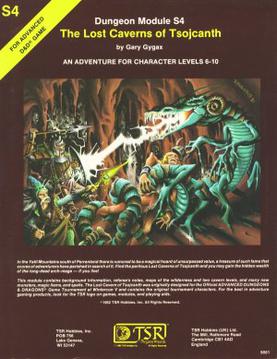
The Lost Caverns of Tsojcanth is an adventure module for the Dungeons & Dragons fantasy role-playing game. It was written by Gary Gygax and published by TSR in 1982 for the first edition Advanced Dungeons & Dragons (AD&D) rules. The 64-page adventure bears the code "S4" and is set in the Greyhawk campaign setting. It is divided into two parts, a 32-page adventure, and a 32-page booklet of monsters and magic items. The plot involves the player characters investigating rumors of lost treasure. After traversing a wilderness and two levels of dungeons, the players face Drelnza, the vampiric daughter of long-deceased archmage Iggwilv.

The lich is an undead creature found in the Dungeons & Dragons (D&D) fantasy role-playing game. Liches are spellcasters who seek to defy death by magical means.
Don Turnbull was a journalist, editor, games designer, and an accomplished piano and pinball player. He was particularly instrumental in introducing Dungeons & Dragons into the UK, both as the managing director of TSR UK Ltd and as the editor of the Fiend Folio.

In the Dungeons & Dragons fantasy role-playing game, the term monster refers to a variety of creatures, some adapted from folklore and legends and others invented specifically for the game. Included are traditional monsters such as dragons, supernatural creatures such as ghosts, and mundane or fantastic animals. A defining feature of the game, monsters are typically obstacles which players must overcome to progress through the game. Beginning with the first edition in 1974, a catalog of game monsters (bestiary) was included along other game manuals, first called Monsters & Treasure and now called the Monster Manual. As an essential part of Dungeons & Dragons, many of its monsters have become iconic and recognizable even outside D&D, becoming influential in video games, fiction, and popular culture.
